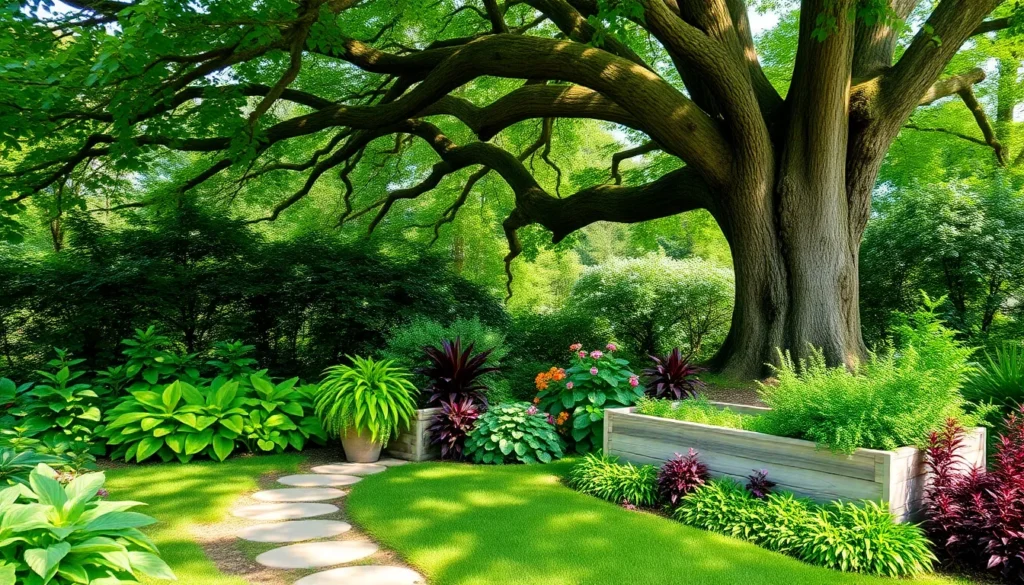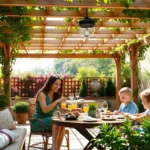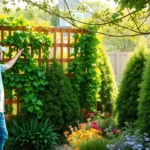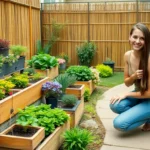Transforming the shaded space beneath your trees into a thriving garden doesn’t have to be a challenge. We’ve discovered that these seemingly difficult areas can become some of the most enchanting spots in your industry when you choose the right plants and design approach.
Many gardeners struggle with bare patches under mature trees thinking nothing will grow there. The truth is these areas offer unique opportunities to create stunning shade gardens that add depth texture and visual interest to your outdoor space. With proper plant selection and strategic planning you’ll turn those forgotten corners into garden gems.
Whether you’re dealing with dense canopy cover shallow roots or dry soil conditions we’ll show you proven techniques that work. From selecting shade-loving perennials to incorporating hardscape elements there are countless ways to maximize these underutilized spaces and create beautiful gardens that thrive year-round.
Shade-Loving Perennial Gardens Under Trees
Perennial gardens under trees create lasting beauty that returns year after year with minimal maintenance. We’ll explore three proven approaches to establish thriving perennial displays in these challenging growing conditions.
Hostas and Ferns for Textural Interest
Hostas offer unmatched foliage variety in shaded garden spaces beneath trees. Large varieties like ‘Sum and Substance’ create dramatic focal points with leaves reaching 18 inches across, while miniature cultivars such as ‘Blue Mouse Ears’ provide delicate edging options. We recommend pairing blue hostas with chartreuse varieties to create striking color contrasts that brighten dim areas.
Ferns complement hostas perfectly through their feathery textures and graceful forms. Christmas ferns maintain their green color throughout winter, providing year round structure when hostas go dormant. Japanese painted ferns add metallic silver highlights that shimmer in filtered light, while royal ferns can reach 4 feet tall to fill vertical space.
Layering these plants by height creates natural looking compositions that mimic woodland settings. We place tall ferns behind medium sized hostas, then edge with smaller varieties to establish flowing transitions. This arrangement maximizes visual impact while allowing each plant adequate growing space.
Astilbe and Heuchera Color Combinations
Astilbe brings vibrant blooms to shaded areas where most flowering perennials struggle to perform. Pink varieties like ‘Fanal’ produce deep rose plumes in early summer, while white cultivars such as ‘Bridal Veil’ create elegant displays against dark backgrounds. Red astilbe varieties provide bold color that stands out in low light conditions.
Heuchera adds continuous foliage color throughout the growing season with leaves in purple, silver, lime green, and coral tones. ‘Palace Purple’ creates dramatic dark backgrounds for lighter colored companions, while ‘Lime Rickey’ brightens shadowy corners with its chartreuse leaves. We use these colorful leaves as living mulch beneath taller perennials.
Strategic color pairing amplifies impact in shade gardens where subtle differences become more important. Purple heuchera with pink astilbe creates sophisticated combinations, while lime colored coral bells with white astilbe brightens the darkest spaces. We repeat these color echoes throughout the planting area to establish visual unity.
Native Woodland Wildflower Plantings
Wild ginger spreads naturally to form living carpets beneath mature trees in our region. This low growing native produces heart shaped leaves that suppress weeds while requiring virtually no maintenance once established. Small burgundy flowers appear at ground level in spring, adding subtle beauty for observant gardeners.
Trilliums provide spectacular spring displays before trees leaf out and create deep shade. These three petaled flowers appear in white, pink, or deep red depending on the species we choose. Wake robin and painted trillium naturalize over time to create impressive colonies that mark the transition from winter to spring.
Bloodroot and mayapple create ephemeral beauty that appears briefly in early spring then disappears until the following year. These native perennials take advantage of high light levels before canopy closure, then go dormant to conserve energy. We plant these alongside evergreen groundcovers to maintain interest after the wildflowers fade.
Ground Cover Solutions for Tree Base Areas
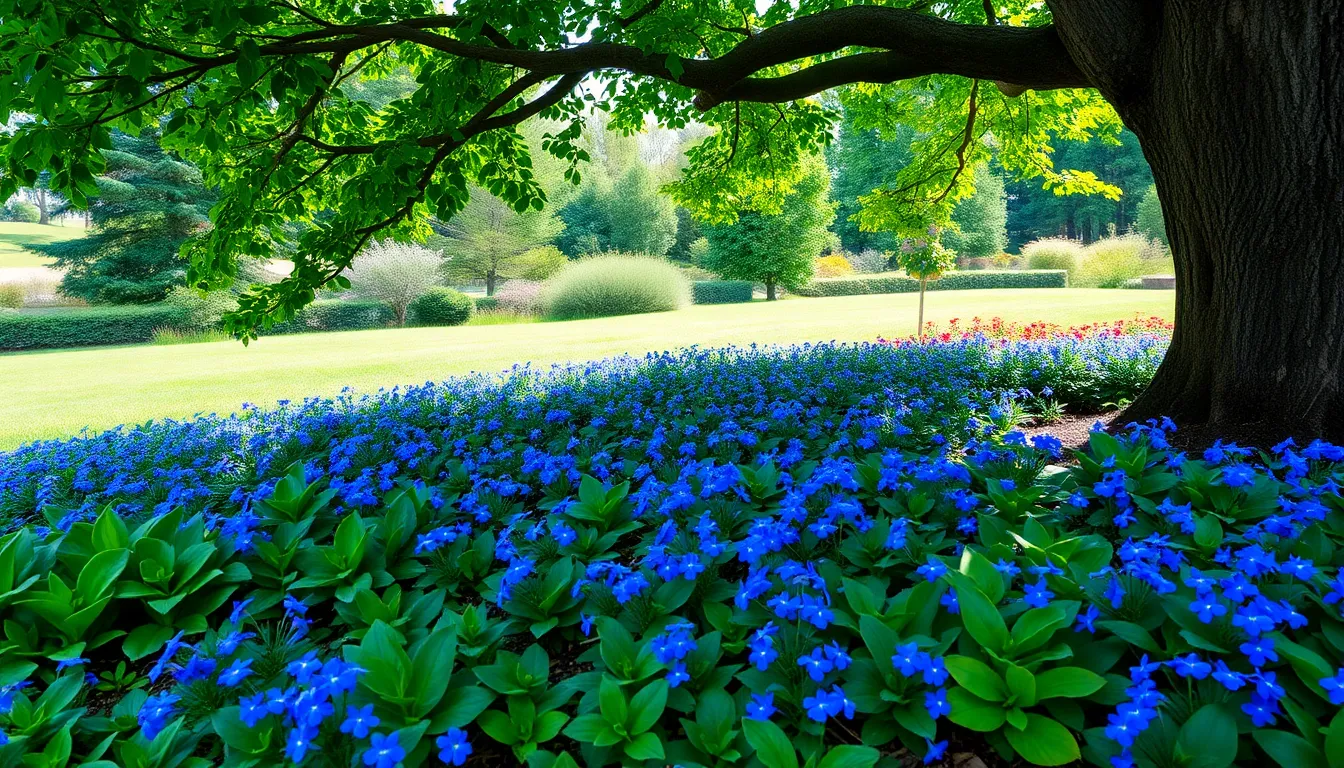
Creating effective ground cover beneath trees requires selecting plants that can handle challenging conditions while providing year round beauty. We’ve identified three proven ground cover strategies that transform bare soil into thriving carpet gardens.
Pachysandra and Vinca Minor Carpets
Pachysandra forms dense evergreen carpets that spread naturally through underground runners. This glossy leafed groundcover thrives in deep shade where other plants struggle to survive. We recommend spacing plants 12 inches apart for quick coverage within two growing seasons.
Vinca Minor creates fast spreading blankets of glossy leaves topped with delicate blue flowers in spring. This versatile groundcover adapts to various light conditions from full shade to partial sun. Growth rates reach 6 to 8 inches per year, making it ideal for covering large areas efficiently.
Both plants require minimal maintenance once established and provide effective weed suppression. Pachysandra reaches heights of 6 to 10 inches while Vinca Minor stays lower at 4 to 6 inches. These drought tolerant options reduce watering needs after the first year.
Ajuga and Lamium Colorful Spreads
Ajuga produces vibrant blue or purple flower spikes in spring that rise above bronze, green, or burgundy foliage. This low growing groundcover spreads through stolons and creates colorful mats 4 to 6 inches tall. We’ve found it particularly effective under deciduous trees where it receives early spring sunlight.
Lamium offers variegated silver and green leaves with pink, purple, or white flowers throughout the growing season. This spreading perennial tolerates dry shade conditions better than most alternatives. Growth patterns create 8 to 12 inch wide clumps that gradually merge into continuous coverage.
Color combinations using both plants create ever-changing seasonal displays with spring flowers followed by attractive foliage patterns. Ajuga provides early season blooms while Lamium continues flowering into fall. These combinations work exceptionally well under maple, oak, and other large shade trees.
Moss Gardens for Natural Appeal
Moss gardens create serene natural landscapes that require virtually no maintenance once established. These primitive plants thrive in the acidic, moist conditions commonly found under evergreen trees. We recommend identifying existing moss species before encouraging their spread.
Natural moss establishment occurs gradually through spore dispersal and moisture retention techniques. Removing competing weeds and maintaining consistent moisture levels promotes healthy moss development. Results typically appear within 6 to 12 months in suitable microclimates.
Maintenance requirements remain minimal with occasional debris removal and moisture monitoring during dry spells. Moss gardens complement natural woodland settings and provide year round green coverage. These living carpets work particularly well under pine, spruce, and fir trees where needle drop creates ideal growing conditions.
Container Garden Arrangements Under Tree Canopies
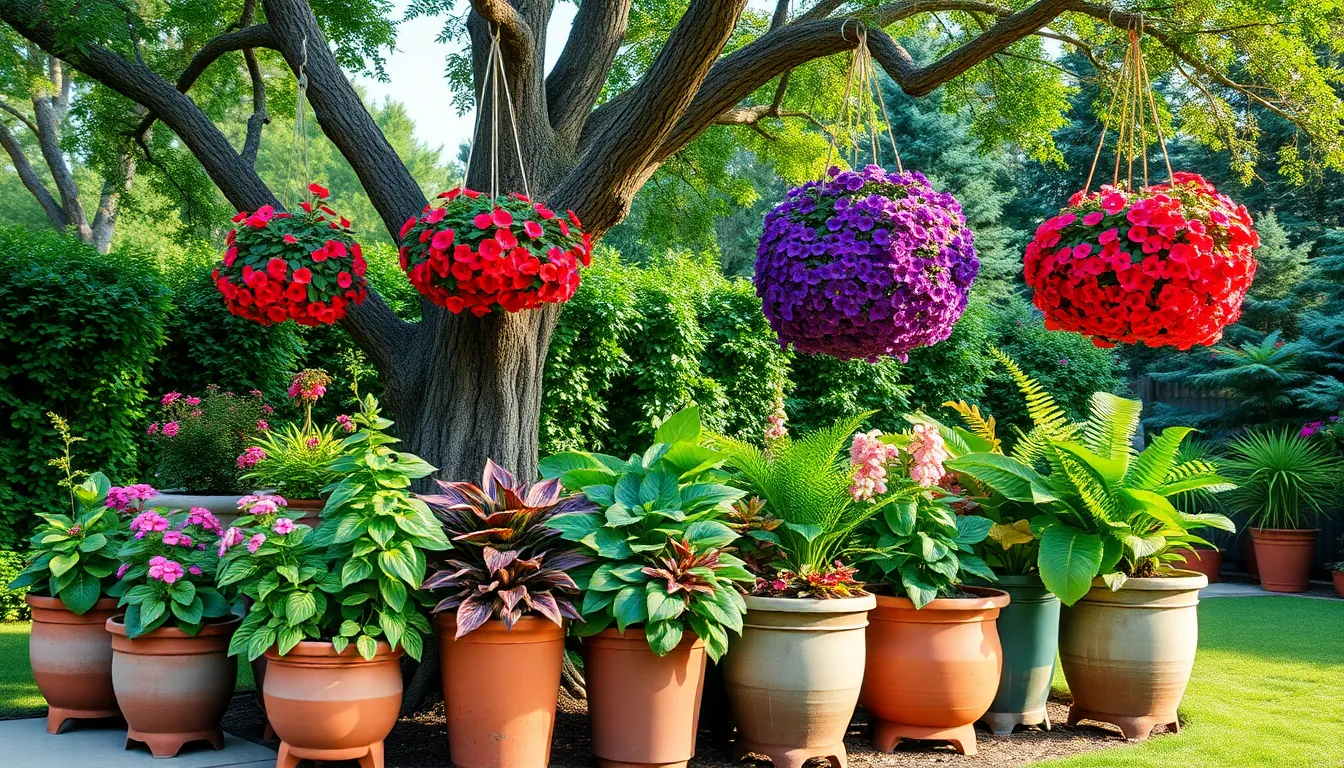
Container gardens offer us a versatile solution for creating beautiful displays beneath tree canopies without disturbing delicate root systems. Moving beyond traditional ground plantings, we can create stunning arrangements that respect the tree’s natural environment while maximizing our garden’s visual impact.
Portable Planter Groupings
Portable planters give us the freedom to experiment with different layouts and seasonal arrangements under our trees. We can group containers of varying heights and sizes to create visual depth, using larger pots as anchor points and smaller ones to fill gaps and add texture. Combining shade loving plants like impatiens, coleus, hostas, and ferns in these groupings creates vibrant displays that thrive in filtered light conditions.
Strategic placement becomes crucial when we’re working with portable arrangements. We position containers on pot feet or wooden blocks to prevent soil compression and protect the tree’s root zone from excessive weight. Moving planters throughout the growing season allows us to follow changing light patterns as tree canopies shift with the seasons.
Seasonal Container Swaps
Seasonal swapping keeps our under tree gardens fresh and exciting throughout the year. We rotate cool weather favorites like pansies and violas during spring and fall months, then transition to heat tolerant options such as impatiens and begonias for summer displays. This approach ensures our containers always feature plants that perform at their peak in current conditions.
Planning our seasonal rotations helps us maintain continuous color and interest. We prepare containers ahead of time, growing plants in a staging area before moving them into position under our trees. Storing off season containers in protected locations extends their lifespan and reduces our gardening expenses over time.
Hanging Basket Installations
Hanging baskets add vertical dimension to our tree canopy gardens without competing for ground space or disturbing root systems. We select sturdy branches that can support the weight of mature baskets, ensuring proper installation with appropriate hardware designed for outdoor use. Trailing plants like creeping fig, caladiums, and various fern species create cascading displays that complement the tree’s natural form.
Installation height matters when we’re creating these aerial gardens. We position baskets where they’ll receive optimal light while remaining accessible for maintenance and watering. Grouping multiple baskets at different heights creates a layered effect that transforms the space beneath our trees into a three dimensional garden room.
Rock and Stone Garden Features Beneath Trees
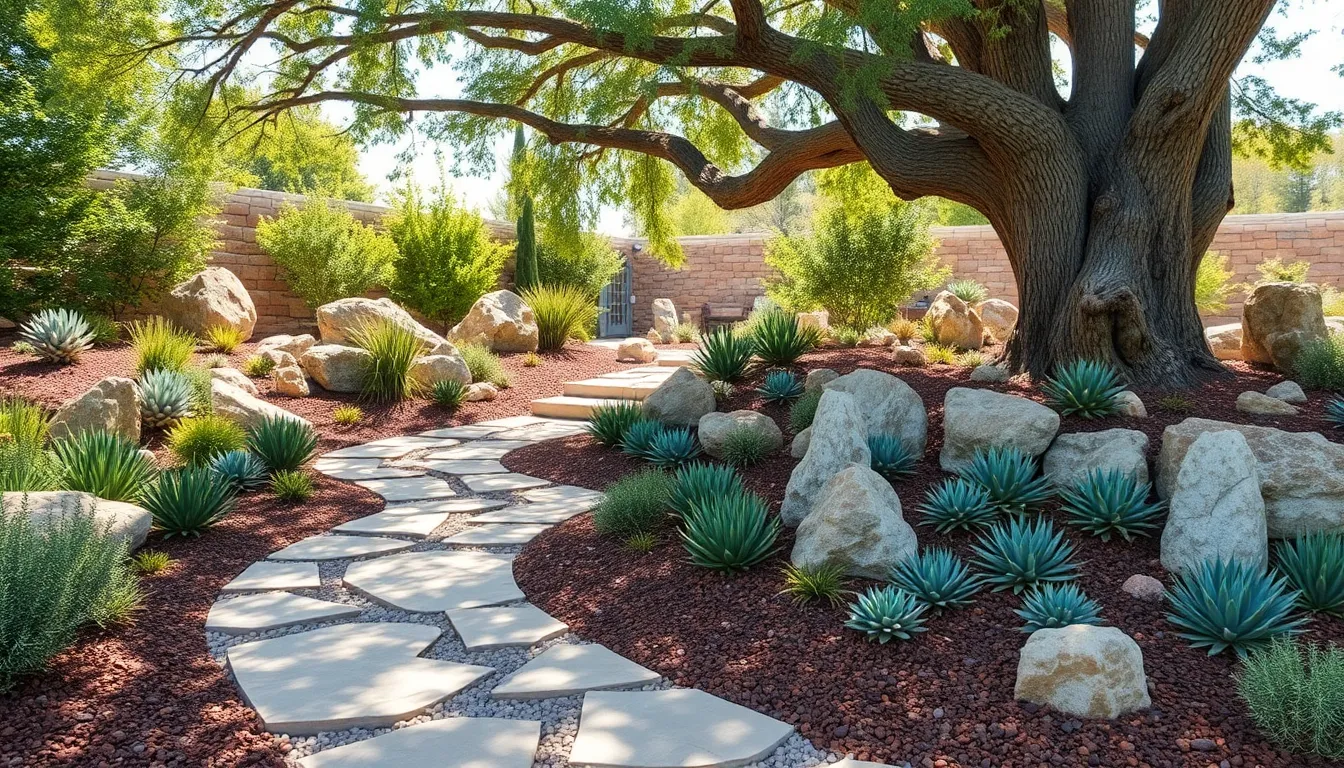
Rock features offer structural beauty while protecting your tree’s delicate root system from damage. These elements create natural focal points that complement the organic shapes of your existing canopy.
Natural Stone Pathways and Borders
Flagstone pathways provide functional walkways that won’t compact soil or harm tree roots beneath the surface. We recommend spacing irregular natural stone pavers to allow proper water penetration and continued root growth. Stone borders define garden areas while creating finished edges that make maintenance tasks much easier.
Slate and natural fieldstone work exceptionally well in frequently shaded areas where traditional materials might fail. These pathway answers eliminate the need for heavy foot traffic on delicate root zones. Border installations using stacked stone create attractive boundaries without requiring deep excavation that could damage your tree’s foundation.
Rock Garden Succulent Displays
Hardy sedums and sempervivums thrive in partial shade conditions where other succulents struggle to survive. We’ve found these varieties adapt well to dry, rocky environments beneath established trees. Rock garden displays featuring these plants add unique textures and seasonal color changes to previously unused spaces.
Proper drainage becomes essential when installing succulent features near tree roots. Small soil pockets between rocks provide adequate growing medium without disturbing the existing root network. These displays require minimal maintenance once established and offer year round visual interest.
Decorative Mulch and Gravel Designs
Chipped bark and river rock create uniform surfaces that control weeds while conserving essential soil moisture. We prefer gravel applications in areas where water runoff isn’t problematic for your industry design. These materials regulate soil temperature effectively and can be arranged in geometric or flowing natural patterns.
Decorative stone mulches suppress unwanted vegetation without competing with tree roots for available nutrients. Bark mulch layers provide organic material that slowly decomposes and enriches the soil over time. Both options create clean, professional appearances that enhance your property’s overall aesthetic appeal.
Raised Bed Gardens Around Tree Trunks
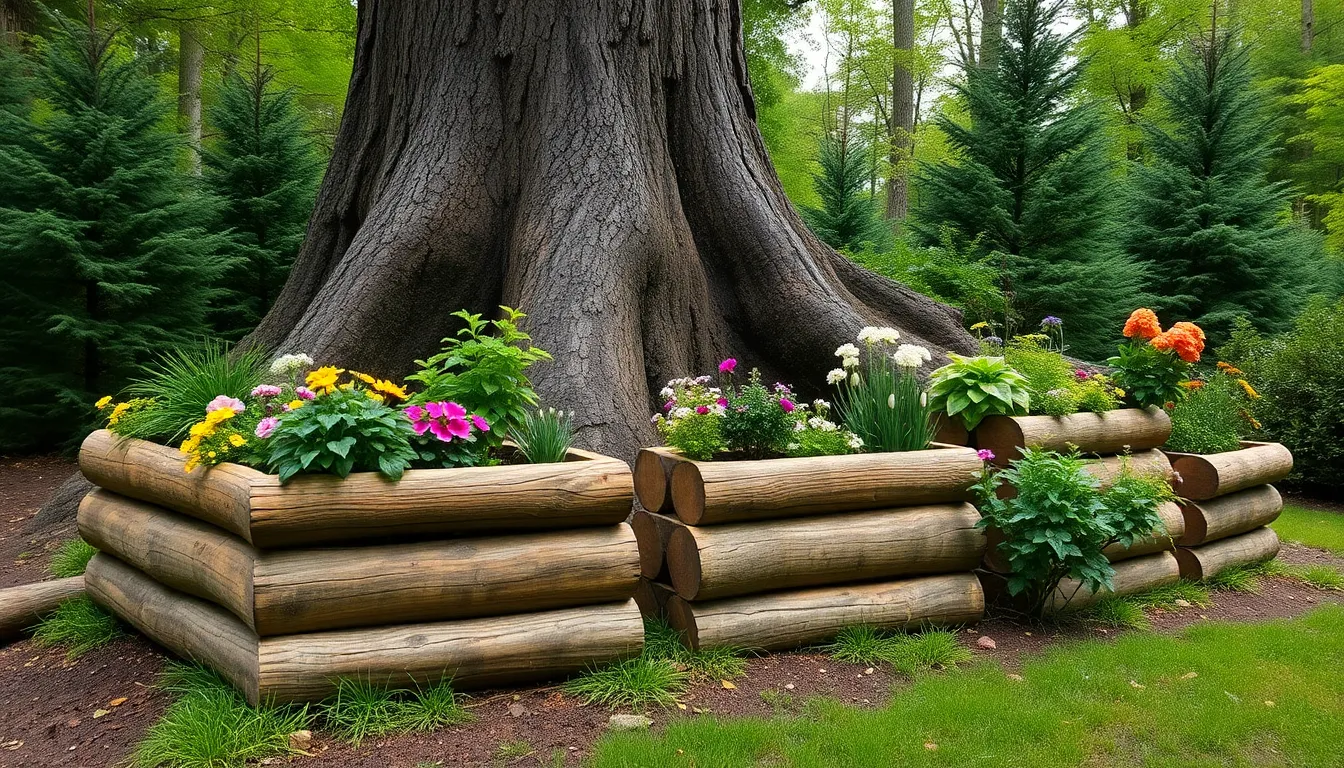
Raised beds offer a practical solution for creating defined planting spaces beneath trees while maintaining proper root health. These elevated structures allow us to add growing medium without directly disturbing the existing root system.
Building Elevated Planting Areas
Constructing elevated planting areas requires careful planning to protect tree roots from damage. We recommend using natural materials like logs and branches to create rustic, functional beds that complement the woodland setting. Log cabin style construction provides excellent structural integrity while utilizing readily available materials from your property.
Building with straight timber sections creates clean lines and professional appearance in your garden design. Natural spruce logs offer exceptional durability and weather resistance for long term installation. Pinterest showcases many inspirational designs that balance aesthetics with functionality for these unique garden features.
Elevated construction allows us to create proper soil depth without adding weight directly onto sensitive root zones. This approach prevents soil compaction while providing adequate growing space for our chosen plants.
Drainage Considerations for Tree Health
Proper drainage stands as the most critical factor when installing raised beds around tree trunks. Trees require oxygen in the top 18 inches of soil to maintain healthy root function and prevent suffocation. Excess soil accumulation can cut off this essential oxygen supply and severely damage or kill the tree.
Installing drainage systems prevents water from pooling around the base of trees during heavy rainfall. We must ensure that water can flow freely away from the trunk area to prevent root rot and other moisture related diseases. Gravel layers beneath the planting medium create effective drainage while maintaining soil structure.
Avoiding soil accumulation directly against tree bark prevents moisture retention that can lead to fungal infections. Strategic placement of drainage materials protects both the tree’s health and our investment in the garden design.
Material Choices for Long Term Durability
Selecting appropriate materials ensures our raised beds will withstand weather conditions and provide years of reliable service. Natural materials like spruce logs resist decay and integrate seamlessly with the forest environment while offering sustainable construction options.
| Material Type | Durability Rating | Cost | Maintenance Level |
|---|---|---|---|
| Spruce Logs | High | Medium | Low |
| Cedar Timber | Very High | High | Very Low |
| Natural Stone | Excellent | High | Minimal |
| Composite Lumber | High | Very High | Minimal |
Timber sections provide structural integrity when properly treated for outdoor use. We recommend choosing materials that naturally resist rot and insect damage to minimize ongoing maintenance requirements. Cedar and other naturally weather resistant woods offer excellent longevity without chemical treatments.
Stone and masonry materials create permanent installations that complement natural settings while requiring minimal upkeep. These materials handle freeze thaw cycles effectively and maintain their appearance over decades of use.
Fairy Garden and Miniature Landscapes Under Trees
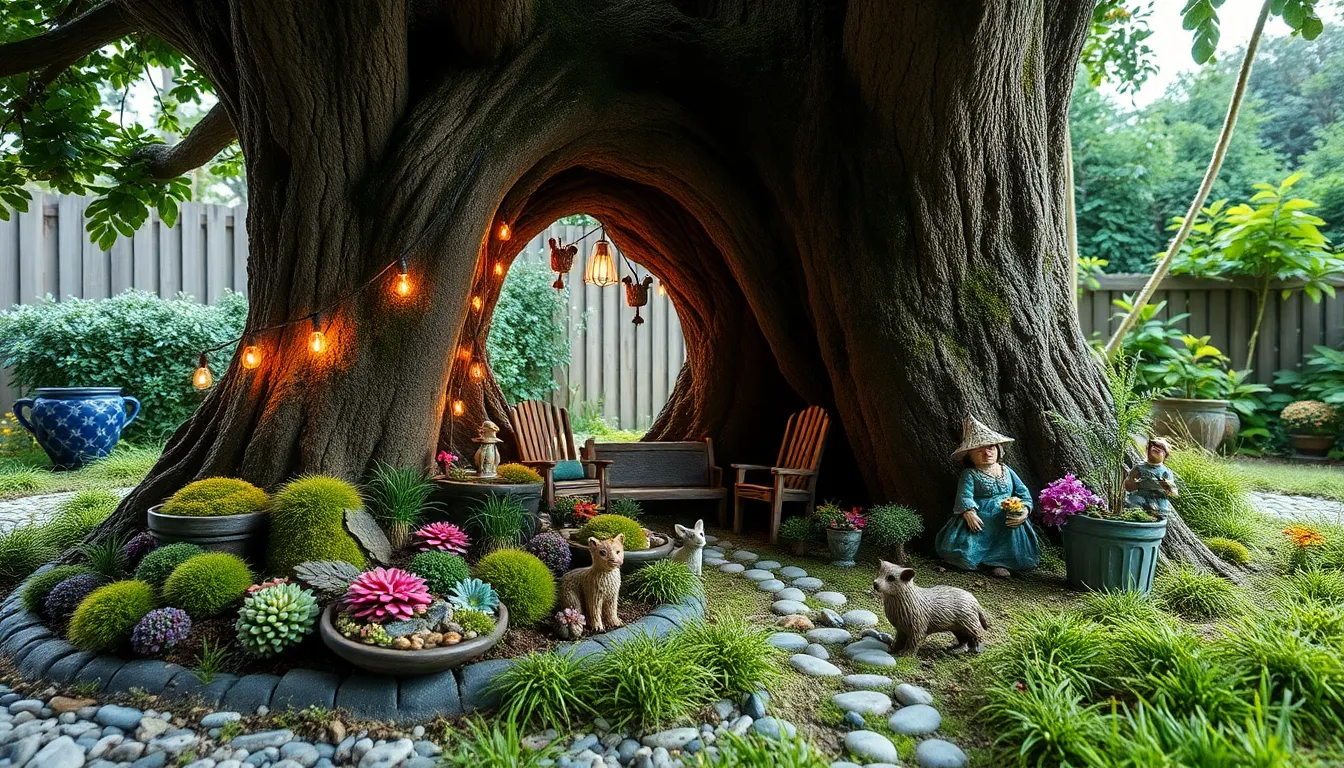
Transform shaded areas beneath trees into enchanting fairytale scenes that capture imagination and create magical outdoor experiences. These miniature worlds thrive in naturally protected environments where dappled light filters through branches above.
Whimsical Decorative Elements
Fairy lights add instant magic to tree base gardens when strung through lower branches or wrapped around trunk bases. We recommend using solar powered LED strings that automatically illuminate at dusk, creating twinkling effects that last throughout the evening hours.
Miniature furniture transforms ordinary spaces into fairy sized living areas with tiny benches, tables, and chairs made from weather resistant materials. Position these pieces near tree roots where natural alcoves form, creating cozy gathering spots for imaginary residents.
Recycled container planters offer creative opportunities using broken teacups, old boots, or ceramic pots as unique fairy houses. These repurposed materials blend seamlessly with natural surroundings while providing functional planting spaces for small specimens.
Animal figurines bring woodland scenes to life with rabbits, squirrels, owls, and hedgehogs strategically placed among plants and decorative elements. Choose pieces made from durable resin or stone that withstand weather conditions year round.
Twig fences and bridges create boundaries and pathways using natural materials collected from your own yard. Bend flexible branches into archways or weave twigs together for rustic barriers that complement the organic tree environment.
Small-Scale Plant Selections
Moss varieties thrive in acidic soil conditions commonly found beneath evergreen trees, creating soft green carpets that require minimal maintenance. Irish moss and cushion moss spread naturally to form dense mats perfect for fairy garden pathways.
Baby’s tears (Soleirolia) produces tiny round leaves that cascade beautifully from containers or spread across shaded ground areas. This plant tolerates low light conditions and creates delicate textural interest in miniature landscapes.
Dwarf hostas offer scaled down foliage in various colors including blue, green, and variegated patterns suitable for fairy garden proportions. Varieties like ‘Blue Mouse Ears’ and ‘Tiny Tears’ remain compact while providing substantial visual impact.
Creeping Jenny spreads quickly to form golden green groundcover that brightens shaded areas with chartreuse colored leaves. This vigorous grower fills spaces between decorative elements while tolerating foot traffic from garden visitors.
Early blooming bulbs including snowdrops, crocuses, and miniature daffodils provide seasonal color before tree canopies fully develop. Plant these in clusters around fairy houses and along pathways for spring enchantment.
Creating Magical Themed Spaces
Organic mulching protects sensitive tree roots while providing proper growing medium for fairy garden plants and accessories. Apply 2-3 inch layers of shredded bark or leaf mold around decorative elements without covering root flares.
Layered plant arrangements create visual depth using height variations from ground hugging moss to medium sized ferns and small shrubs. Position taller elements toward the back near tree trunks with shorter plants cascading forward.
Pebble pathways guide visitors through fairy garden scenes using smooth river rocks or decorative gravel that allows water penetration to tree roots below. Create winding routes that encourage exploration of different themed areas.
Water features enhance magical atmospheres with miniature ponds created from shallow dishes or small fountains powered by solar pumps. Position these elements away from major root zones to prevent soil saturation issues.
Nighttime lighting extends enjoyment hours using battery operated lanterns, LED spotlights, or glow in the dark paint on selected decorative pieces. Install fixtures that highlight key features without overwhelming the natural shade environment.
Water Feature Integration in Tree Gardens
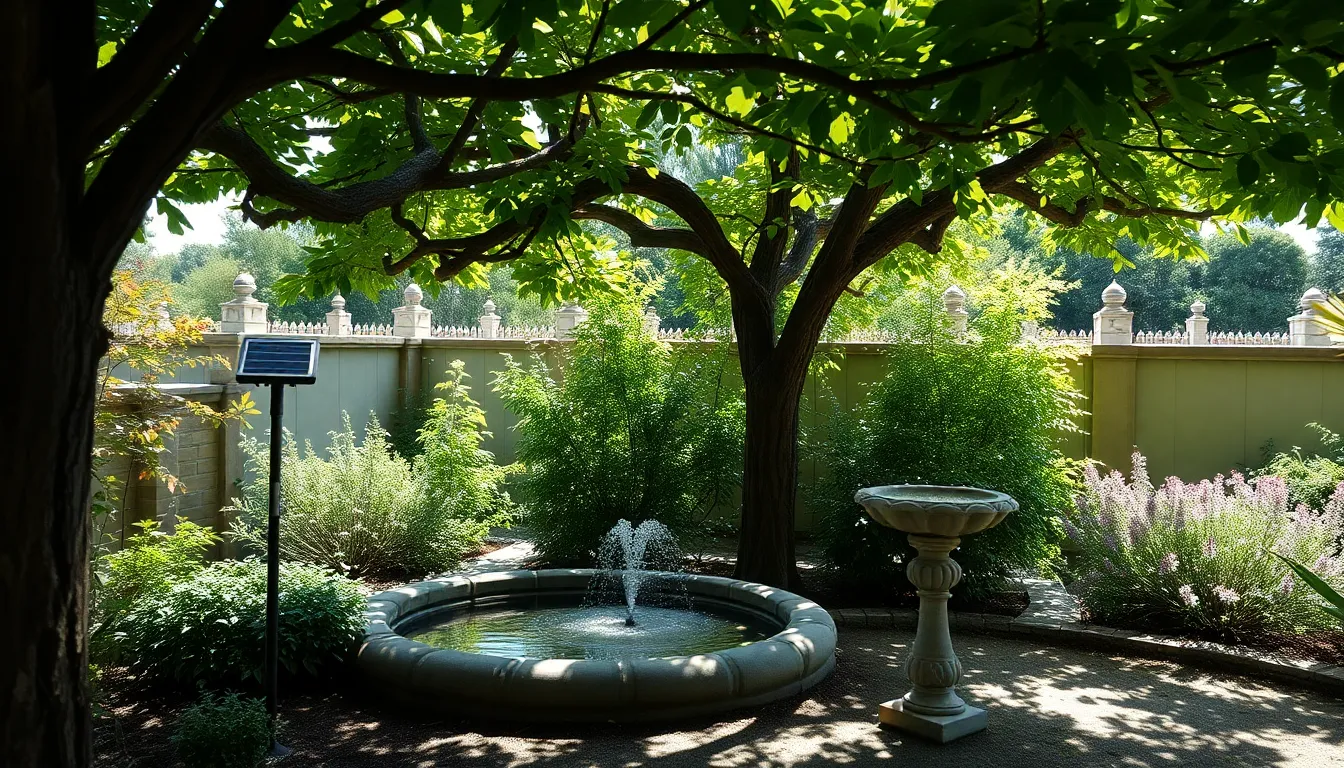
Water features bring life and tranquility to shaded garden spaces while creating focal points that complement the natural beauty of tree canopies. These installations work harmoniously with existing root systems when properly positioned and designed.
Small Fountain Installations
Small fountains create soothing sounds that mask urban noise while adding visual interest to shaded garden areas. We recommend positioning compact bubble fountains 3-4 feet from tree trunks to avoid root damage while maintaining easy access for maintenance. Solar powered fountains work exceptionally well in partially shaded locations, requiring minimal electrical work and operating costs.
Tabletop fountains offer flexibility for seasonal arrangements and can be moved as needed to accommodate changing light conditions. Stone and ceramic models blend naturally with woodland settings, while metal options provide modern contrast against organic textures. Installation depth should remain shallow to protect surface roots, typically requiring excavation of only 6-8 inches for most compact units.
Birdbath Placement Strategies
Birdbaths positioned under tree canopies attract wildlife while providing natural entertainment for garden observers. We suggest placing these water features in areas with filtered sunlight where birds feel secure from predators yet have clear flight paths for quick escapes. Depth should remain between 1-2 inches to accommodate various bird species safely.
Elevated birdbaths on pedestals work better than ground level installations in shaded areas, keeping water visible and accessible while preventing debris accumulation from fallen leaves. Natural stone materials integrate seamlessly with woodland aesthetics, though lightweight resin options allow for seasonal repositioning. Fresh water replacement every 2-3 days prevents mosquito breeding and maintains optimal conditions for visiting birds.
Rain Chain and Collection Systems
Rain chains transform ordinary downspouts into decorative water features that guide rainwater through garden spaces aesthetically. We install these systems to direct water flow toward collection basins or rain gardens positioned safely away from tree root zones. Copper and aluminum chains develop attractive patinas over time while maintaining structural integrity through weather changes.
Collection systems paired with rain chains create sustainable water sources for garden irrigation during dry periods. Underground cisterns work well in areas with established root systems, while above ground rain barrels provide easier access for maintenance and water distribution. Overflow systems prevent water accumulation that could damage tree roots, directing excess water toward appropriate drainage areas through decorative channels or buried pipes.
Edible Garden Options for Shaded Tree Areas

We can transform those challenging shaded spaces beneath trees into productive food gardens that provide fresh ingredients for our kitchen. These areas offer unique growing conditions that certain edible plants actually prefer over full sun locations.
Shade-Tolerant Herb Selections
Chives thrive exceptionally well in partial shade conditions and require minimal maintenance once established. These versatile herbs grow in compact clumps and provide continuous harvests throughout the growing season without demanding constant attention.
Mint varieties flourish in shaded environments where they spread naturally to create fragrant ground cover. We recommend containing mint in planters or defined borders since it can quickly overtake other plants in garden beds.
Parsley grows best in partial shade with consistently moist soil conditions. Both flat leaf and curly varieties produce abundant harvests when protected from intense afternoon sun that can cause the leaves to become bitter.
Leafy Green Vegetable Varieties
Lettuce varieties adapt beautifully to partial shade environments where they stay crisp longer than in full sun gardens. Cool season lettuces like butterhead and romaine actually prefer filtered light that prevents them from bolting too quickly in warm weather.
Kale tolerates shade remarkably well while producing nutrient dense leaves that become sweeter after light frost exposure. We find that kale grown in partial shade develops more tender leaves with less bitter flavors compared to sun grown plants.
Spinach prefers the cooler conditions found in shaded areas where it can produce multiple harvests before hot weather causes it to bolt. This nutritious green grows continuously in partial shade during spring and fall seasons.
Berry Bushes and Fruit Plants
Black raspberries demonstrate excellent shade tolerance with their natural clumping growth habit that makes them perfect for planting under tree canopies. These berries produce sweet fruit while requiring less water than their sun loving counterparts.
Currant bushes offer both red and black varieties that tolerate shade conditions while producing clusters of tart berries perfect for jams and baking. Some currant varieties also provide pleasant fragrance that enhances the garden atmosphere beneath trees.
Gooseberries function effectively as natural hedging plants while producing fruit in partial shade conditions. We can use these hardy bushes to create defined borders around tree base areas while harvesting their unique tart berries for culinary purposes.
Seasonal Interest Gardens Under Mature Trees
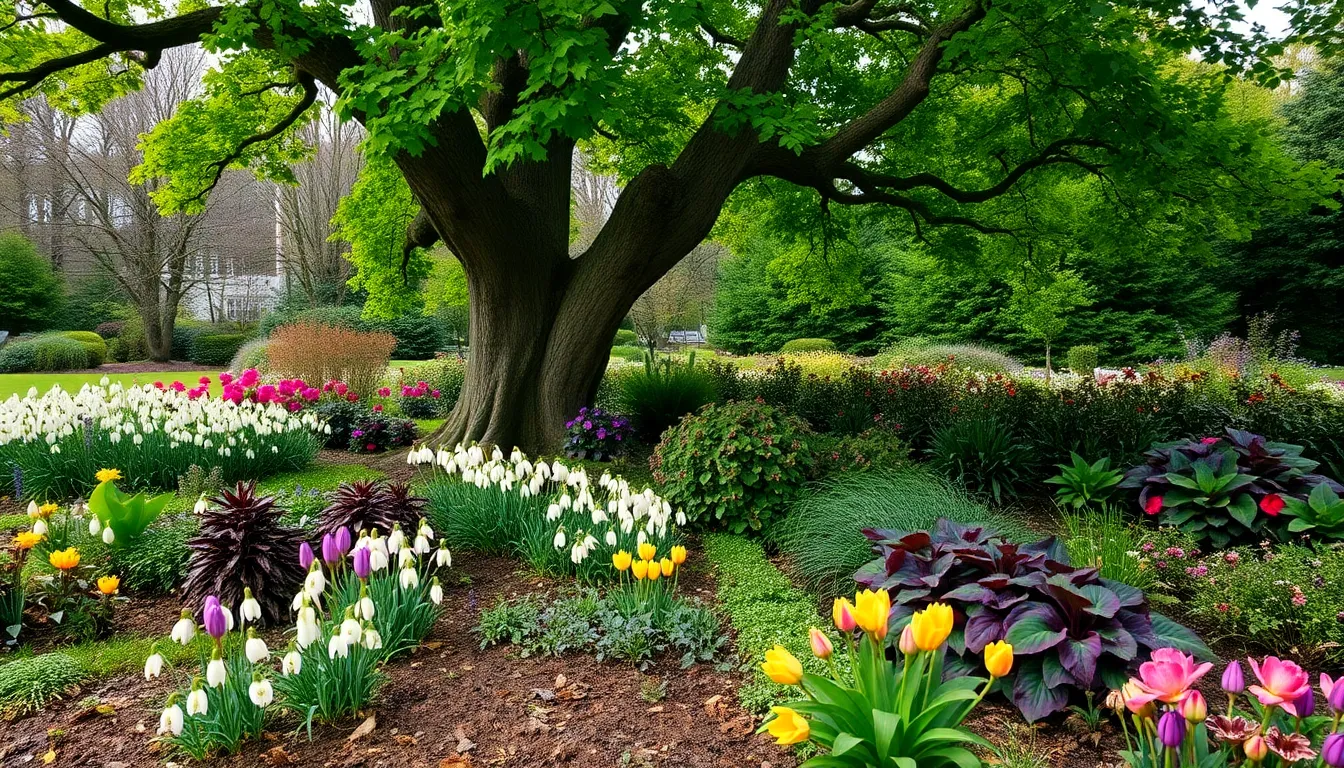
Creating gardens beneath mature trees that captivate throughout the year requires strategic plant selection for each season. We’ll show you how to design layered landscapes that transform shaded areas into ever-changing displays from spring through winter.
Spring Bulb Naturalizations
Spring bulbs deliver spectacular early season color beneath tree canopies before leaves fully emerge and block precious sunlight. We recommend planting snowdrops and winter aconites first since they bloom as early as January, followed by crocuses, snowflakes, and fritillaries that extend the display through March.
Narcissi and tulips create bold mid spring statements when planted in drifts of 15 to 25 bulbs per grouping. Early varieties like Tête-à-Tête daffodils and Darwin hybrid tulips perform exceptionally well in these conditions. Alliums and camassias round out the sequence, providing blooms well into May while their foliage dies back naturally without requiring removal.
Muscari and grape hyacinths excel at naturalizing under trees, multiplying from initial plantings of 50 bulbs to colonies of several hundred within 3 to 4 years. Mixing these with primroses, pansies, and early blooming tulips creates resilient understory displays that require minimal annual maintenance once established.
| Spring Bulb Type | Bloom Period | Naturalization Rate | Planting Depth |
|---|---|---|---|
| Snowdrops | January-February | High | 3 inches |
| Crocuses | February-March | Moderate | 4 inches |
| Narcissi | March-April | High | 6 inches |
| Tulips | April-May | Low | 8 inches |
Summer Flowering Shade Plants
Summer interest depends on selecting shade tolerant perennials and annuals that thrive with limited sunlight and root competition from established trees. Hostas anchor summer displays with their varied foliage textures, from narrow lance shaped leaves to broad heart shaped varieties that can span 4 feet across at maturity.
Astilbes contribute feathery flower plumes in white, pink, and red shades during June and July, while their ferny foliage remains attractive throughout the growing season. Ferns like Christmas fern and painted fern add graceful textures that complement both hostas and astilbes without competing for nutrients.
Hellebores and heucheras provide continuous color through their distinctive foliage, with heucheras offering lime green, burgundy, and coral toned leaves that persist from spring through fall. Structural plants including oakleaf hydrangeas, azaleas, rhododendrons, and viburnum species add height variation while producing seasonal blooms that enhance garden appeal without compromising tree health.
Fall Color and Winter Structure
Fall displays emerge through plants that produce vibrant autumnal foliage or persistent berries that extend visual interest into winter months. Dogwoods (Cornus species) deliver brilliant red and orange leaf color while their distinctive branching patterns create winter silhouettes beneath tree canopies.
Viburnums excel at providing dual season value with their fall berry displays in shades of red, blue, and black that attract birds while adding color to the garden. American holly and winterberry holly species offer evergreen structure and bright red berries that persist through December and January when other plants have gone dormant.
Evergreen shrubs including boxwood, rhododendron, and mountain laurel maintain garden form throughout winter while hardy perennials like hellebores and certain fern species provide textural elements that bridge the transition from fall to spring. These winter interest plants ensure year round appeal while requiring minimal maintenance during dormant seasons.
Maintenance Tips for Thriving Tree Gardens
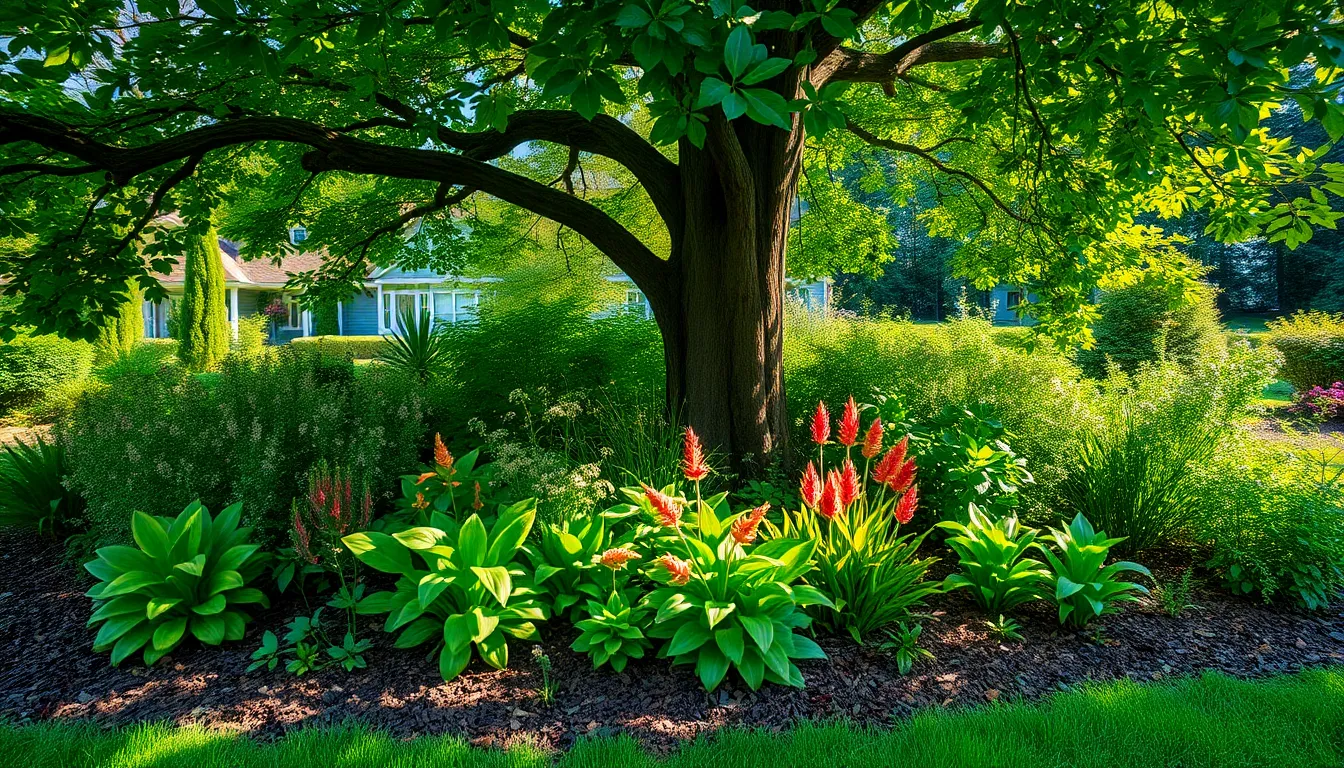
Successful garden maintenance under trees requires understanding the unique challenges of competing root systems and reduced sunlight. We’ll share proven strategies that keep your tree garden healthy and vibrant throughout the growing seasons.
Watering Strategies for Competing Roots
New plantings need intensive watering during their establishment period. For native trees, we recommend applying several gallons of water three times weekly for the first two weeks, then gradually reducing frequency as root systems develop. During the critical first two years, thorough watering ensures your trees develop strong, drought-resistant foundations.
Mulching creates an effective moisture retention system. Organic materials like bark chips, leaf debris, or pine needles help reduce water competition between tree roots and garden plants. We’ve found that a 3-4 inch layer of mulch significantly decreases watering frequency while maintaining consistent soil moisture.
Deep watering techniques work better than frequent shallow applications. Rather than daily sprinkles, we saturate the soil thoroughly once or twice per week, encouraging roots to grow deeper and become more resilient. This approach also prevents surface root development that can compete with your understory plants.
Fertilization and Soil Amendment Techniques
Organic mulch provides natural nutrient cycling for mature trees. As bark, leaves, and pine needles decompose, they release essential nutrients directly into the root zone. But, younger trees often require additional fertilizers during their first few growing seasons to establish vigorous growth patterns.
Soil testing reveals exact amendment needs for your tree garden. We check pH levels and adjust them according to plant requirements, typically adding lime for acidic soils or sulfur for alkaline conditions. Most shade plants prefer slightly acidic to neutral soil conditions.
Compost incorporation improves both drainage and fertility simultaneously. Adding 2-3 inches of well-aged compost annually enhances soil structure while providing slow-release nutrients. We work compost into the top few inches of soil, being careful not to damage shallow tree roots.
Pruning and Care Considerations
Dead and damaged branch removal promotes healthy tree structure. We eliminate broken, crossing, or diseased branches before the growing season begins, allowing trees to direct energy toward new growth. This preventive approach reduces pest problems and improves air circulation throughout the canopy.
Young tree support systems prevent wind damage during establishment. Stakes and tree ties provide necessary stability for newly planted trees, but we inspect and adjust these supports regularly to prevent bark damage. Remove supports once trees develop sufficient trunk strength, typically after 1-2 years.
Winter protection strategies safeguard roots during cold temperatures. We apply fresh mulch layers each fall to insulate the root zone and prevent freeze-thaw cycles that can damage tender roots. Also, we avoid using rock salt for de-icing near trees, as it can harm root systems and reduce plant health.
Conclusion
We’ve shown you that the space beneath your trees doesn’t have to remain barren or challenging. With the right combination of plants hardscape elements and creative design approaches you can transform these shaded areas into some of the most enchanting parts of your outdoor space.
Whether you choose low-maintenance ground covers colorful container arrangements or productive edible gardens the key lies in working with your tree’s natural conditions rather than against them. By selecting appropriate plants and implementing proper care techniques you’ll create thriving gardens that enhance both the beauty and functionality of your industry.
Remember that success comes from understanding your exact site conditions and choosing answers that complement your tree’s health and your garden goals. Start with one approach that appeals to you most and gradually expand your under-tree garden as you gain confidence and experience.
Frequently Asked Questions
Can anything actually grow under trees in shaded areas?
Yes, many plants thrive under trees with proper selection. Shade-loving perennials, groundcovers, and woodland plants naturally adapt to these conditions. The key is choosing species that prefer filtered light and can compete with tree roots for nutrients and water.
What are the best plants for deep shade under mature trees?
Hostas, ferns, astilbe, and heuchera are excellent choices for deep shade. Native woodland plants like wild ginger, trilliums, and bloodroot also thrive. These plants offer varied textures, colors, and seasonal interest while requiring minimal maintenance.
How do I create a garden without damaging tree roots?
Use container gardens, raised beds with proper drainage, or lightweight groundcovers that don’t require deep soil cultivation. Avoid heavy machinery and excessive digging near the trunk. Focus on surface-level planting and organic mulching to protect delicate root systems.
What groundcovers work best around tree bases?
Pachysandra and Vinca Minor provide dense, low-maintenance coverage in deep shade. Ajuga and Lamium offer colorful flowers and attractive foliage. Moss gardens create serene, natural carpets in acidic, moist conditions under evergreen trees.
Can I grow vegetables and herbs in shaded tree areas?
Yes, many edibles tolerate partial shade. Leafy greens like lettuce, kale, and spinach thrive in filtered light. Shade-tolerant herbs include chives, mint, and parsley. Berry bushes like black raspberries and currants also perform well in these conditions.
How do I maintain proper drainage around trees?
Install drainage systems in raised beds to prevent water pooling. Use natural stone pathways that allow water penetration. Apply organic mulch to retain moisture while preventing soil compaction. Avoid overwatering, which can lead to root rot.
What’s the best way to add structure to shade gardens?
Incorporate hardscape elements like natural stone borders, decorative gravel, and rock features. Use container arrangements for flexibility. Create pathways with flagstone or stepping stones. Add vertical interest with hanging baskets on sturdy branches.
How can I create year-round interest in tree gardens?
Plant spring bulbs like snowdrops and crocuses for early color. Use summer-flowering shade plants like astilbe and hostas. Include fall-color plants like dogwoods and viburnums. Maintain winter structure with evergreen shrubs and decorative elements.
Are water features suitable for tree gardens?
Yes, small-scale water features work well. Position compact bubble fountains away from tree trunks to avoid root damage. Solar-powered options require minimal maintenance. Birdbaths in filtered sunlight attract wildlife while complementing the natural setting.
How often should I water plants under trees?
Deep, infrequent watering works best to encourage deep root growth. Water early morning to reduce evaporation. Apply 2-3 inches of organic mulch to retain moisture. Monitor soil moisture regularly, as tree canopies can block rainfall.

